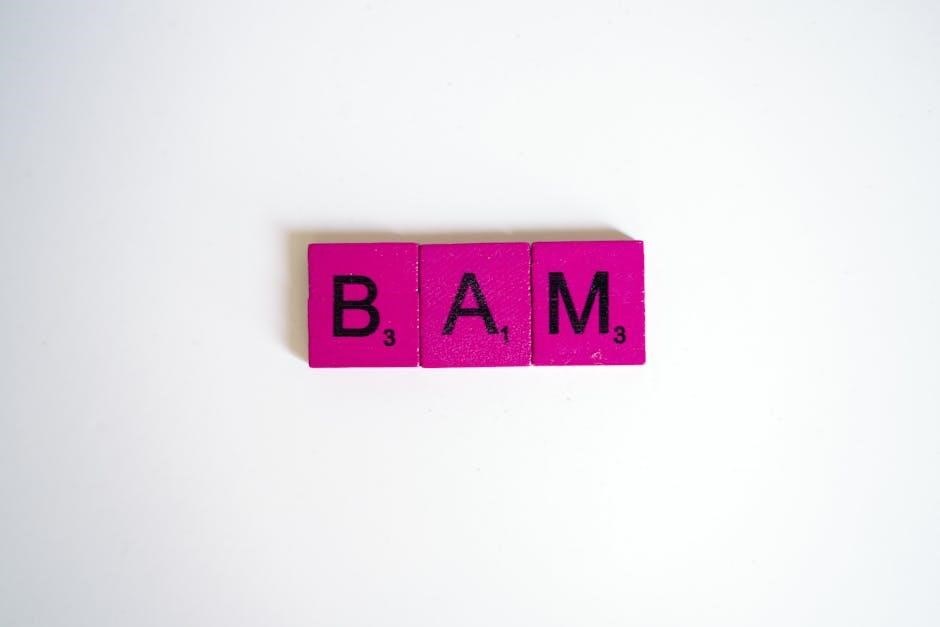
Vocabulary building is essential for grade 3 students, enhancing reading comprehension, communication skills, and academic success. It lays a strong foundation for future learning and confidence.
1.1 Importance of Vocabulary Development in Early Grades
Vocabulary development in early grades is crucial for building a strong foundation in reading, writing, and communication. Expanding a child’s word bank enhances their ability to understand texts, express ideas clearly, and engage in meaningful conversations. A robust vocabulary also improves critical thinking and problem-solving skills, as students learn to interpret context and nuances in language. Early exposure to a variety of words prepares children for academic success, fostering confidence and a lifelong love for learning. By introducing age-appropriate vocabulary, educators and parents equip young learners with tools to navigate complex concepts and express themselves effectively in all areas of life.

1.2 Benefits of Learning Vocabulary at Grade 3 Level
Learning vocabulary at the Grade 3 level offers numerous benefits, including improved reading comprehension, enhanced communication skills, and better academic performance. Expanding word knowledge helps students understand complex texts, express ideas clearly, and engage confidently in conversations. Vocabulary skills also strengthen critical thinking and creativity, as students learn to interpret meanings and apply words in different contexts. Additionally, a strong vocabulary foundation fosters a love for reading and learning, preparing students for future challenges in various subjects, such as science, social studies, and literature. By mastering vocabulary at this stage, students build a lifelong skill that enhances their personal and educational growth.
1.3 How to Use Vocabulary Lists Effectively
Using vocabulary lists effectively involves integrating them into daily learning routines. Start by breaking down lists into manageable chunks, focusing on a few words at a time. Use flashcards or digital tools like Rewordify.com to simplify complex texts and reinforce meanings. Encourage interactive activities such as matching games, word searches, or crossword puzzles to make learning engaging. Parents and teachers can incorporate real-life examples to help students connect words with their surroundings. Consistency is key—spend a few minutes each day reviewing and practicing. Tracking progress through quizzes or discussions ensures retention and understanding. Make learning fun by incorporating stories, songs, or group exercises. Regular practice and positive reinforcement will help students master vocabulary lists effectively.

Vocabulary Words with Meanings for Grade 3
Vocabulary building for Grade 3 introduces essential words, enhancing reading and communication skills. Lists include common terms like “community” and “environment,” supported by flashcards and interactive apps for better learning.
2.1 List of Common Vocabulary Words for Grade 3
A curated list of essential vocabulary words for Grade 3 students includes terms like “community,” “environment,” and “celebrate.” Each word is paired with clear, age-appropriate definitions to aid understanding. Examples include:
– Community: A group of people living together in an area.
– Environment: The surroundings in which people, animals, and plants live.
– Celebrate: To mark a special occasion with joy.
These words are chosen to align with curriculum standards, fostering better comprehension of texts and enhancing communication skills. Flashcards, worksheets, and interactive games are recommended tools for effective learning. Regular practice with these words ensures strong retention and a solid foundation for future academic success.
2. Related to Animals and Their Habitats
Teaching vocabulary related to animals and their habitats introduces Grade 3 students to essential terms like habitat, migration, and predator. A habitat is the natural home of an animal, while migration refers to seasonal movements to find food or shelter. Predator describes an animal that hunts others for food, and prey is the animal being hunted. Other key words include hibernate (to sleep through winter) and nest (a structure built for shelter). These terms help students understand ecosystems and wildlife behaviors. Using flashcards and pictures can make learning engaging, while incorporating these words into sentences reinforces their meanings and promotes a deeper connection to science and nature.
2.3 Vocabulary Words for Colors, Shapes, and Sizes
Learning vocabulary for colors, shapes, and sizes helps Grade 3 students describe the world around them. Common color words include red, blue, green, yellow, and purple. Shape-related terms are circle, square, rectangle, triangle, and oval. Size vocabulary includes big, small, tall, short, long, and round. These words are essential for daily communication and problem-solving. Activities like matching games and drawing can reinforce these concepts. Understanding these terms improves descriptive writing and math skills. Flashcards and real-life examples make learning engaging and interactive, helping students grasp these fundamental concepts effectively. This foundational vocabulary builds a strong base for future academic success and creative expression.

Activities to Reinforce Vocabulary Learning
Engaging activities like word searches, crossword puzzles, and matching games help students practice and retain vocabulary. Interactive games and group exercises make learning fun and effective.
3.1 Word Searches and Crossword Puzzles
Word searches and crossword puzzles are engaging tools for reinforcing vocabulary. These activities make learning fun by challenging students to find and recognize words. They improve retention and spelling skills while introducing new words in a playful context. Crossword puzzles, in particular, encourage critical thinking and problem-solving. Teachers can create puzzles using grade-specific vocabulary lists or use pre-made templates. Online tools and educational apps also offer interactive versions, making it easier for students to practice anywhere. By incorporating these activities, students develop a stronger connection to the words, enhancing their overall vocabulary development and comprehension abilities. These exercises are both educational and enjoyable.
3.2 Matching Games: Words and Pictures
Matching games that pair words with pictures are an excellent way to help grade 3 students build vocabulary. These activities are interactive and visually engaging, making learning enjoyable. By matching words to corresponding images, students develop a clearer understanding of word meanings and contexts. For example, matching the word “apple” with a picture of an apple reinforces recognition and memory. Teachers and parents can create these games using flashcards or digital tools. Online platforms offer ready-to-use templates, while educational apps provide interactive versions. Matching games improve retention, enhance visual association, and make vocabulary learning fun. This method is particularly effective for young learners, as it combines visual and linguistic skills, fostering a deeper connection to new words.
3.3 Creating Flashcards for Better Retention
Creating flashcards is a proven method to enhance vocabulary retention for grade 3 students. Flashcards typically feature a word on one side and its definition, pronunciation, or image on the other. This dual-sided format helps students associate words with their meanings visually and contextually. Flashcards can be made using index cards or digital tools like apps and online platforms. They allow for spaced repetition, a technique that improves long-term memory by reviewing words at increasing intervals. Students can quiz themselves or have others test them, making the process interactive. Flashcards are portable, enabling practice anywhere, and they provide immediate feedback, reinforcing learning. Regular use of flashcards helps build a strong vocabulary foundation, boosting confidence and academic performance.

Resources for Grade 3 Vocabulary Practice
- Interactive worksheets and activity sheets for hands-on learning.
- Engaging online games and quizzes to make practice fun.
- Recommended educational apps for consistent vocabulary practice.
4.1 Worksheets and Activity Sheets
Worksheets and activity sheets are excellent tools for reinforcing vocabulary skills in grade 3 students. They provide structured exercises such as crossword puzzles, word searches, and fill-in-the-blank sentences. These resources help students practice word meanings, spellings, and usage in sentences. Many worksheets are available in PDF format, making them easy to download and print. They often include visual aids like pictures to aid comprehension. Teachers and parents can use these activities to track progress and identify areas needing review. Interactive and engaging, worksheets make learning fun while ensuring retention of new vocabulary. Regular practice with these tools builds confidence and improves language skills effectively.
4.2 Interactive Online Games and Quizzes
Interactive online games and quizzes are dynamic tools for engaging grade 3 students in vocabulary learning. Platforms like Kahoot! and Quizlet offer games that make learning fun and competitive. These resources often include crossword puzzles, word searches, and matching games that reinforce memory and understanding. Advanced search techniques, such as using file type filters, can help locate PDFs with interactive activities tailored for young learners. Tools like Rewordify.com simplify complex texts, aiding comprehension. These games and quizzes provide immediate feedback, helping students track progress and build confidence. Regular use of these resources fosters a love for learning while ensuring retention of new vocabulary in an enjoyable and effective manner.
4.3 Recommended Apps for Vocabulary Learning
Several apps are highly recommended for effective vocabulary learning in grade 3. Apps like Kahoot! and Quizlet offer interactive games and flashcards that make learning engaging. These tools allow students to practice vocabulary through quizzes, matching games, and audio pronunciations. Additionally, apps like Memrise and DUOLINGO provide child-friendly interfaces and rewards systems to motivate young learners. Many of these apps also support PDF resources, enabling teachers to import lists of vocabulary words for customized practice. Features such as pronunciation guides, example sentences, and progress tracking help students master new words efficiently. These apps are accessible on both tablets and smartphones, making vocabulary learning fun and convenient for grade 3 students.

Assessing Vocabulary Progress
Regular quizzes, oral exams, and progress tracking help assess vocabulary learning. Tools like worksheets and online quizzes ensure understanding and correct usage of new words effectively.
5.1 Quizzes and Tests
Quizzes and tests are effective tools for assessing vocabulary progress in Grade 3 students. They help identify strengths and areas needing improvement. Regular quizzes ensure retention and correct usage of words. Teachers can use worksheets, online quizzes, or interactive games to make assessments engaging. Tests also track progress over time, providing insights into learning growth. Parents and educators can use these results to adjust teaching methods. Quizzes with pictures or matching games add fun, while written tests evaluate spelling and understanding. Consistent testing builds confidence and reinforces new vocabulary, making it an essential part of the learning process for young students.
5.2 Oral Exams and Discussions
Oral exams and class discussions are valuable for assessing vocabulary comprehension in Grade 3 students. They allow teachers to evaluate pronunciation, understanding, and the ability to use words in context. Students gain confidence in articulating thoughts clearly and accurately. Discussions encourage critical thinking and teamwork, while oral exams test individual mastery. These methods help identify gaps in knowledge and ensure students can apply vocabulary meaningfully. Regular oral assessments also foster a deeper connection to the material, making learning engaging and interactive for young learners. They complement written tests, providing a well-rounded evaluation of vocabulary skills and progress over time.
5.3 Tracking Improvement Over Time
Tracking improvement over time is crucial for monitoring progress in vocabulary learning for Grade 3 students. Regular assessments, such as quizzes and discussions, help identify growth and areas needing attention. Teachers can use progress charts or digital tools to record advancements, ensuring students stay on track. By reviewing performance regularly, educators can adjust teaching strategies to meet individual needs. Celebrating milestones builds confidence and motivates students to continue learning. Over time, this systematic approach helps students develop a robust vocabulary, essential for academic success and lifelong communication skills. Consistent tracking ensures no child is left behind and fosters a love for learning new words.

Tips for Parents and Teachers
Encourage daily practice, use real-life examples, and make learning fun. Incorporate vocabulary into conversations and activities to reinforce retention and understanding for Grade 3 students effectively.
6.1 Encouraging Daily Practice
Encouraging daily practice is crucial for effective vocabulary building in Grade 3 students. Parents and teachers can create a routine where students engage with vocabulary words for 10-15 minutes daily. This can include reading aloud, using flashcards, or incorporating words into simple sentences. Making practice interactive, such as through games or quizzes, helps maintain interest. Additionally, connecting new words to real-life examples or personal experiences enhances retention. Consistency is key, as regular exposure reinforces memory and understanding. Encouraging students to use vocabulary in conversations or creative writing also deepens their grasp of word meanings.
6.2 Using Real-Life Examples
Using real-life examples is an effective way to help Grade 3 students understand and retain vocabulary words. By connecting new words to familiar situations or objects, students can grasp meanings more easily. For instance, explaining the word “habit” by discussing daily routines like brushing teeth or reading before bed makes it relatable. Parents and teachers can create flashcards with words on one side and a personal or real-life context on the other. Incorporating stories or images that illustrate word meanings also enhances learning. This approach makes vocabulary building interactive and engaging, helping students see the practical use of words in their everyday lives. Consistent exposure to real-world examples strengthens comprehension and confidence in using new vocabulary.
6.3 Making Learning Fun and Engaging
Making vocabulary learning fun and engaging is crucial for Grade 3 students. Interactive activities like word games, puzzles, and storytelling can captivate young learners. Using songs, rhymes, or role-playing helps students associate words with memorable experiences. Parents and teachers can incorporate movement, such as acting out vocabulary words, to make learning dynamic. Additionally, creating a “Word of the Day” tradition with visual aids or crafts can foster excitement. Technology tools, like educational apps or interactive quizzes, also make learning enjoyable. By blending creativity and play, vocabulary building becomes a positive and impactful experience for children, encouraging them to explore and enjoy language learning actively. This approach fosters a lifelong love for learning and improves retention naturally.

Common Challenges in Vocabulary Learning
Grade 3 students often face challenges like pronunciation difficulties, understanding word contexts, and managing large volumes of new words, requiring tailored strategies for effective learning.
7.1 Overcoming Difficulties in Pronunciation
Pronunciation challenges can hinder vocabulary learning for grade 3 students. To address this, teachers and parents can use audio resources to demonstrate correct sounds. Flashcards with phonetic spellings help students practice regularly. Encouraging repetition and mimicking native speakers improves accuracy. Interactive games and songs can make learning engaging. Breaking words into syllables and emphasizing rhythm also aids comprehension. Consistent practice and positive feedback build confidence, ensuring students master pronunciation effectively.
7.2 Understanding Word Context and Usage
Understanding word context and usage is crucial for grade 3 students to grasp meanings effectively. Teaching students to identify context clues in sentences helps them deduce definitions. Using flashcards with example sentences can clarify word usage. Reading comprehension exercises expose students to words in different scenarios, enhancing their ability to interpret meanings. Interactive activities, like role-playing or creating short stories, make learning engaging. Visual aids, such as diagrams or pictures, can also illustrate word contexts. Encouraging students to use words in their own sentences reinforces understanding. This approach ensures students not only learn definitions but also how to apply words appropriately in various situations, improving their overall communication skills.
7.3 Managing a Large Number of Words
Managing a large number of vocabulary words can be challenging for grade 3 students. To simplify, organize words into categories like animals, colors, or shapes. Use flashcards or apps to track progress and review regularly. Breaking words into smaller parts, such as prefixes or suffixes, can aid memorization. Incorporate interactive games and quizzes to make learning fun and engaging. Encourage students to create their own lists or drawings to visualize meanings. Setting daily goals helps prevent overwhelm and ensures steady progress. Teaching strategies like grouping similar words or focusing on high-utility words can make learning more efficient and effective for young learners.
Vocabulary building is crucial for grade 3 students, enhancing their communication and academic skills. With consistent practice and engaging tools, students can confidently master new words and meanings.
8.1 Summary of Key Points
Vocabulary building for Grade 3 students is vital for improving reading comprehension, communication, and academic performance. Using tools like word lists, flashcards, and interactive games enhances learning. Incorporating real-life examples and parental involvement strengthens retention. Regular practice and engaging activities ensure long-term mastery. Consistent exposure to new words and their meanings fosters a strong foundation for future success. Combining these strategies creates a comprehensive approach to vocabulary development, making learning both effective and enjoyable for young students.
8.2 Encouragement for Continued Learning
Encouraging Grade 3 students to continue learning vocabulary is crucial for their academic growth. Celebrate their progress, no matter how small, to build confidence and motivation. Emphasize the joy of discovering new words and their meanings, as it opens doors to better understanding and communication. Encourage daily practice through fun activities like reading, puzzles, or games. Remind them that learning is a lifelong journey, and every word mastered brings them closer to achieving their goals. Positive reinforcement and support from parents and teachers play a significant role in fostering a love for learning. Keep the process engaging and rewarding to inspire continued effort and curiosity.

Frequently Asked Questions (FAQs)
Q: How can I find vocabulary lists for Grade 3? A: Use Google to search for “vocabulary words with meaning for Grade 3 PDF” to find relevant resources.
Q: What tools can help learn vocabulary? A: Flashcards, word games, and online quizzes are effective for engaging vocabulary practice.
Q: How often should students practice? A: Daily practice, even for 10-15 minutes, helps reinforce new words and their meanings effectively.
9.1 How Many Words Should a Grade 3 Student Learn?
A Grade 3 student should aim to learn around 100-150 new vocabulary words annually. This pace helps build a strong foundation without overwhelming them. Teachers and parents can introduce 10- weekly, focusing on understanding and usage. Regular practice through flashcards, reading, and conversations ensures retention. Quality matters more than quantity, so prioritizing meaningful context and repetition is key. Consistent learning fosters confidence and improves communication skills. By the end of Grade 3, students should comfortably recognize and use these words in everyday situations, preparing them for advanced learning in higher grades.
9;2 What Are the Best Methods for Retaining Vocabulary?
Effective vocabulary retention for Grade 3 students involves consistent practice and engaging techniques. Flashcards are a popular tool, allowing students to review words regularly. Spaced repetition systems, where words are revisited at increasing intervals, enhance long-term memory. Incorporating words into sentences or stories helps students understand context and usage. Interactive games, like matching words to pictures or crossword puzzles, make learning fun and memorable. Reading aloud and discussing word meanings in class or at home also reinforces retention. Teaching synonyms, antonyms, and word families further deepens understanding. Encouraging students to use new words in their writing or conversations ensures practical application and better retention over time.

9.3 How Can Parents Support Vocabulary Development?
Parents play a vital role in supporting their child’s vocabulary development. Encouraging daily reading and discussing unfamiliar words can significantly enhance understanding. Using online tools like Google Search for definitions or translation services can also help. Parents can create flashcards or word walls at home to reinforce new words. Engaging in conversations that incorporate new vocabulary and providing opportunities for practical application are effective strategies. Consistency and positive reinforcement are key to helping children retain and confidently use new words in their daily lives.